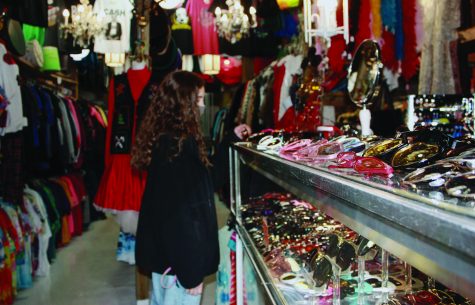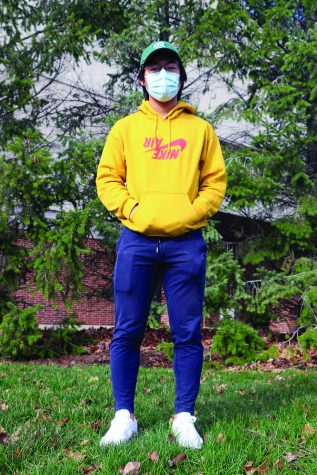For the Aesthetic
Students connect “aesthetics” to identity, perception of others

Senior Alexis “Lexi” Carter admires a pair of sunglasses on display at Broad Ripple Vintage. Carter said she would describe herself as a “Granola Girl”, or someone who enjoys being outdoors and spirituality who also tends to dress in more muted earth tones.
According to senior Alexis “Lexi” Carter, her friends often view her as owning a “hippie-like” or “granola” aesthetic, exemplified by her love of the outdoors, comfortable fashion, vegan diet and fondness for crystals.
This concept of aesthetics has enjoyed a recent boom in social media popularity and pop culture, with the number of Google searches for “aesthetic” and related terms such as “cottagecore,” “granola aesthetic” or “dark academia” all peaking in recent months. As aestheticism has permeated into pop culture, Carter said, like many, she perceives the meaning of “aesthetic” to go far beyond its dictionary definition of visual appeal.
“I would define (aesthetic) as how others perceive you,” Carter said, “and that can be even with the way that you talk, the way that you dress, the kind of belongings that you have—the things that you naturally just go towards and their categories.”
According to Kurt Hugenberg, psychological and brain sciences professor and director of the Stereotyping, Prejudice, and Facial Expression Lab at IU Bloomington, the emergence of various pop culture aesthetics is essentially the result of categorization and stereotyping, a part of human nature that plays a big role in our perception of others.
“(Stereotyping and categorization) are almost always used in our first impressions of others. If you’re going to see me as a middle-aged white guy, you’re probably going to make guesses—maybe that I enjoy watching football more than I like folding origami or gardening. These guesses may be wrong, but they are stereotypes, and they’re going to guide the conversation,” Hugenberg said. “How you treat me affects how I treat you, so these initial guesses for how to start an interaction play out throughout the interaction. Now if we’d known each other for years, you’d know that I would actually much prefer to fold origami than I would to watch football.”
Hugenberg said this stereotyping and categorization applies to the modern-day concept of aesthetic as well, when people might make assumptions about someone’s lifestyle based on their fashion or vice versa. As for how various aesthetics have actually developed, Carter said most are influenced by their beliefs and the people around them.
“Definitely my parents influenced how I originally started to develop this aesthetic,” Carter said. “My parents dress kind of in the same way that I do, and they have similar values to me socially, politically and with the environment and all that. I think that they definitely contributed to that, but also as I began to develop my own interests in life, think for myself and get interested in a bunch of different other things, I think that my style and my aesthetic reflected that.”

Junior Adrien Qi poses wearing some popular streetwear brands such as an Anti Social Social Club hat and Nikes, specifically the Nike SB Dunk Lows. Qi said he does not think it is necessarily important to curate an image for yourself, but rather to find what hobbies you enjoy and to create a space for yourself within that. He also said that this usually leads to you finding your style and aesthetic.
From his experience, Adrien Qi, co-founder of Resell Club and junior, said aesthetics can be similar to brand imaging, a major part of the reselling process—a process where products, often brand clothes, are resold by a third party for a profit. A lot of brands popular in the reselling industry begin in the skating community, according to Qi, and emphasize an “anti-traditionalist” aesthetic.
“I think brand loyalty is one of the most important parts (of reselling). If we look into specific brands like Supreme, the box logo is one of their iconic logos. Just seeing it gives a lot of people a sense of loyalty, but I think nowadays a lot view it as more cliché,” Qi said. “Nowadays, it’s really hard to see someone wear a Supreme box at school, just because it’s like flexing and a lot of people don’t find that super aesthetic.”
Qi also said social media has allowed for ease of conceptualization of “visual ideas” in aesthetics, fashion or otherwise. Senior Kylie McPherson said she has experienced this impact of social media firsthand, as she owns a Pinterest account with over 28,000 monthly viewers currently.
“I think (the popularity of aesthetics) has risen, and I think that comes from social media and the people that are big on social media,” McPherson said. “The one that keeps coming to my mind is (YouTuber and influencer) Emma Chamberlain. I feel like she’s influenced a lot of fashion trends. And I think aesthetics—that’s become a more mainstream word; everybody knows what that means.”
Hugenberg said while people often seek out communities that align with their beliefs, whether through social media or in-person, their communities can also impact their beliefs.
“People tend to seek out group memberships that they want to identify with,” Hugenberg said, presenting himself in several hypothetical examples. “Perhaps I want to become a vegan because I want to signal the fact, say, that I’m left-leaning and young. Or with gun ownership, maybe I want to signify that I’m right-leaning and Midwestern. So I’ll seek out identities that signal the things that I value, but it’s also the case that when we join a group, part of the process of joining a group is learning what the norms of the group are. And there’s quite a lot of research that shows that when folks are being socialized as a member of a new group, their attitudes tend to shift to be in line with that group.”

Senior Lexi Carter (right) poses with her mother, Julie Carter (left), at the Sleeping Bear Dunes in Michigan on July 19, 2019. Carter said a cause she believes in is preserving the environment, a value that has been imparted on her by both of her parents.
McPherson, for instance, said she has felt herself sometimes influenced by online aesthetics communities, such being inspired in her fashion choices, room decor or study motivation, but personally has not experienced sustained influence as she values her own style first.
Similarly, Qi said it is important to appreciate your own aesthetic.
“If you personally like wearing (brands such as Supreme) and that psychologically makes you feel better, it just makes you more confident,” Qi said. “If other people are looking down on that, I don’t think we should really care about them.”
In the end, Carter said values should come first, and other aspects of lifestyle and identity, aesthetics or otherwise, will naturally follow.
“I would think that your beliefs would come first,” Carter said. “I wasn’t purposely like, ‘Okay, this is who I want to be.’ It was just kind of like, ‘This fits for me.’ This is the kind of person I want to be, but it naturally happened. It just reflected what I was thinking.”

